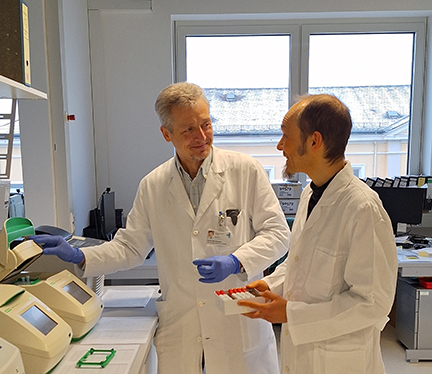The National Foundation for Ectodermal Dysplasias has granted $27,500 to Drs. Nicolai Peschel (shown above) and Holm Schneider for a study to develop a non-invasive test to diagnose x-linked hypohidrotic ectodermal dysplasia (XLHED) prenatally. The team is following-up on Prof. Angus Clarke’s similar study that the NFED funded in 2019.
Once developed, the non-invasive test will help mothers considering the Edelife clinical study know if their unborn child has XLHED. In EDELIFE, timing of the treatment is critical.
We are proud to support this ongoing research. Following is a summary of their research project.
Non-Invasive Prenatal Diagnosis (NIPD) Of XLHED: Cell-Free Fetal DNA Analysis To Identify Pathogenic EDA Variants
Researchers: Dr. Nicolai Peschel & Dr. Holm Schneider, University Hospital Erlangen, Erlangen, Germany

The DNA of the fetus enters the mother’s bloodstream during pregnancy and can be detected in a small blood sample taken from a pregnant woman. In the case of a genetic disease, such as X-linked hypohidrotic ectodermal dysplasia (XLHED), for which protein replacement therapy is currently being tested in a clinical study (Edelife trial), treatment must take place before birth, when the tooth germs and sweat glands form.
If a pregnant woman is faced with the question of whether her unborn child is affected and treatment should be considered, timely diagnosis is therefore a crucial prerequisite.
In our current NFED-funded research, we aim to develop a test for XLHED based on a blood sample from the pregnant woman. Similar tests, known as non-invasive prenatal diagnostics, are already on the market, at least for very large chromosomal abnormalities, e.g., trisomy 21. However, no such test is yet available for analyzing a small DNA segment of a specific gene.
How The Test Would Work to Diagnose XLHED Prenatally
There are other options for early prenatal diagnosis, but these involve invasive procedures with risks for the fetus. We plan to isolate fetal DNA fragments that circulate in the mother’s blood. The DNA comes mainly from dead blood cells which have shed their genetic material. However, this happens both with the cells of the pregnant woman and those of her fetus.
It is difficult to distinguish the genetic material of the fetus from that of the mother, and the amount of fetal DNA in the mother’s blood is very small – usually only about 5%. Another problem is the similarity of the mother’s and child’s DNA. So we are dealing with a very small amount of DNA and we also have to take advantage of certain properties of the child’s DNA fragments to distinguish them from the mother’s DNA.
It is known, for example, that the DNA fragments of the child and the mother differ in length by around 20 base pairs. We want to use this size difference to enrich the DNA of the fetus in our sample compared to that of the mother, which should then enable the isolation and sequencing of the smaller DNA fragments.
The advantages of such a test would be that it could be carried out both early in pregnancy and non-invasively, and that the blood could be taken on site, e.g. at the nearest gynecologist. Once established, it would also be of great benefit for the ongoing Edelife trial.
You can also learn more about the Edelife Clinical Trial being sponsored by EspeRare and Pierre Fabre by vising the official Edelife site.
